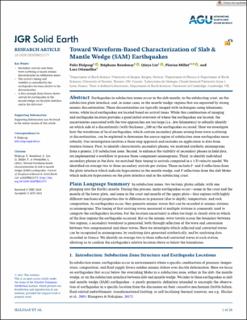| dc.description.abstract | Earthquakes in subduction zones occur in the slab mantle, in the subducting crust, on the subduction plate interface, and, in some cases, in the mantle wedge–regions that are separated by strong seismic discontinuities. These discontinuities are typically imaged with techniques using teleseismic waves, while local earthquakes are located based on arrival times. While this combination of imaging and earthquake location provides a good initial overview of where the earthquakes are located, the uncertainties associated with the two approaches are too large (i.e., few kilometers) to robustly identify on which side of a discontinuity (with thickness urn:x-wiley:21699313:media:jgrb55116:jgrb55116-math-0001100 m) the earthquakes occurred. Here we investigate how the waveforms of local earthquakes, which contain secondary phases arising from wave scattering at discontinuities, can be exploited to determine the source region of subduction zone earthquakes more robustly. Our investigation involves a three-step approach and includes an application to data from western Greece. First, to identify characteristic secondary phases, we analyzed synthetic seismograms from a generic 2-D subduction zone. Second, to enhance the visibility of secondary phases in field data, we implemented a workflow to process three-component seismograms. Third, to identify individual secondary phases in the data, we matched their timing to arrivals computed in a 3-D velocity model. We identified on average two to three secondary arrivals per station. These include P- and S-reflections from the plate interface which indicate hypocenters in the mantle wedge, and P-reflections from the slab Moho which indicate hypocenters on the plate interface and in the subducting crust. | en_US |

